
Talking while reading
 Early Literacy Aside--Explain: Talking with your children while reading, encouraging them to make comments and ask questions is one way to share a book that develops your child's understanding of the book. Make reading with your child a postive experience by allowing your child to make comments and ask questions. Try to focus all your attention on your child for that time.During the storytime, demonstrate these techniques with one or more of your books. Point out what you are doing.
Early Literacy Aside--Empower: Talking with your children and giving them time to respond is supervaluable, even in a conversation consisting entirely of baby babble. This helps your children develop conversation skills. Remember that it can take young children from 5 to 12 seconds to process a question and formulate a response, so it's really important to gie them that extra time to express themselves.
Early Literacy Aside--Explain: Talking with your children while reading, encouraging them to make comments and ask questions is one way to share a book that develops your child's understanding of the book. Make reading with your child a postive experience by allowing your child to make comments and ask questions. Try to focus all your attention on your child for that time.During the storytime, demonstrate these techniques with one or more of your books. Point out what you are doing.
Early Literacy Aside--Empower: Talking with your children and giving them time to respond is supervaluable, even in a conversation consisting entirely of baby babble. This helps your children develop conversation skills. Remember that it can take young children from 5 to 12 seconds to process a question and formulate a response, so it's really important to gie them that extra time to express themselves.
Submitted by Cindy Christin, Bozeman (MT) Public Library and Tracey J., Sacramento (CA) Public Library
Nursery Rhymes
 Early Literacy Aside--Empower: Rhymes help teach "phonological awareness," an awareness of the sounds that make up words. You may have noticed that your child enjoys the way a nursery rhyme sounds even if it doesn't make much sense to him. When you introduce a new rhyme or song, repeat it at least twice. Three times is even better. And be sure to keep repeating the old, familiar rhymes too.
Submitted by Cindy Christin, Bozeman (MT) Public Library
Early Literacy Aside--Empower: Rhymes help teach "phonological awareness," an awareness of the sounds that make up words. You may have noticed that your child enjoys the way a nursery rhyme sounds even if it doesn't make much sense to him. When you introduce a new rhyme or song, repeat it at least twice. Three times is even better. And be sure to keep repeating the old, familiar rhymes too.
Submitted by Cindy Christin, Bozeman (MT) Public Library
Dialogic Reading
 Demonstrate aspects of dialogic reading* by asking open-ended questions during your sharing of a book.Book Introduction: With this next book we are going to focus on what we call "dialogic" or "interactive reading."
Read a book. Come back to a picture and ask a question that cannot be answered with yes or now.
Early Literacy Aside--Example: This technique of sharing a book helps develop their narrative skills, their ability to describe things and experiences.
Early Litearcy Aside--Empower: Try dialogic or interactive reading at home with your child. Simply ask questions about what you've read. You can say, Guess what will happen next or relate the story to your child's real experience. Try to ask questions that cannot be answered with yes or no, or just by pointing to the pictures. Having the children talk about the book helps the develop narrative skills. Also, when the child gives a one-word response, you might expand on what she said, adding description or more information.
Demonstrate aspects of dialogic reading* by asking open-ended questions during your sharing of a book.Book Introduction: With this next book we are going to focus on what we call "dialogic" or "interactive reading."
Read a book. Come back to a picture and ask a question that cannot be answered with yes or now.
Early Literacy Aside--Example: This technique of sharing a book helps develop their narrative skills, their ability to describe things and experiences.
Early Litearcy Aside--Empower: Try dialogic or interactive reading at home with your child. Simply ask questions about what you've read. You can say, Guess what will happen next or relate the story to your child's real experience. Try to ask questions that cannot be answered with yes or no, or just by pointing to the pictures. Having the children talk about the book helps the develop narrative skills. Also, when the child gives a one-word response, you might expand on what she said, adding description or more information.
Submitted by Cindy Christin, Bozeman (MT) Public Library * This webpage of the Talker Script from the first edition of Every Child Ready to Read @ your library initiative of the American Library Association gives more background on dialogic reading: http://www.earlylit.net/readytoread/indexE.shtml#scripts Scroll down under Scripts and click on Talkers. You can also use the Dialogic Reading Handout shown on this webpage.
Songs
 Early Literacy Aside--Explain: Singing songs is one good way for children to become aware of the different sounds that make up words. We call this phonological awareness. Singng helps them get a feel for the rhythm of language and how words are divided into syllables because there is a different note for each syllable. This will help them sound out words when they learn to read.
Submitted by Cindy Christin, Bozeman (MT) Public Library
Early Literacy Aside--Explain: Singing songs is one good way for children to become aware of the different sounds that make up words. We call this phonological awareness. Singng helps them get a feel for the rhythm of language and how words are divided into syllables because there is a different note for each syllable. This will help them sound out words when they learn to read.
Submitted by Cindy Christin, Bozeman (MT) Public Library
What Shall We Do With the Boo-Hoo Baby? by Cressida Cowell
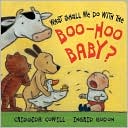
Submitted by Cindy Thompson, Roanoke City (VA) Public Library
Pig's Picnic by Keiko Kasza
 Read book Pig's Picnic by Keiko Kasza. Retell the story using props. Have the children retell the story as you maneuver the props.Early Literacy Aside--Example: Using props is one way to help your child remember the story as they try to retell it. When they can retell a story, it helps their understanding.
Read book Pig's Picnic by Keiko Kasza. Retell the story using props. Have the children retell the story as you maneuver the props.Early Literacy Aside--Example: Using props is one way to help your child remember the story as they try to retell it. When they can retell a story, it helps their understanding.
At the end of storytime hold up the handout of Pig's Picnic (below) and demonstrate how you have cut out the pieces so that the children can retell the story. Early Literacy Aside--Empower: You can strength your children's narrative skills, the ability to tell stories, by taking home this storytime handout, having your children cut out the pictures and retell the story. As they retell the story they may add ideas of their own! pigs-picnic-hand-out.doc Submitted by Laura Mikowski, Hillsboro (OR) Public Libraries
Night in the Country by Cynthia Rylant
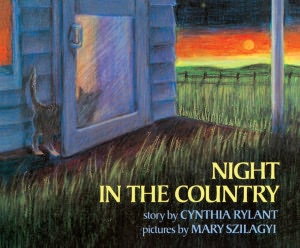
Submitted by Sharon Lindsay, Rockbridge Branch, Bath County (VA) Public Library
Whose House Is This? by Charles Reasoner
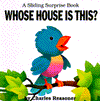 Early Literacy Aside--Explain: There are many ways we can help children enjoy books as we share books together. Children who have positive experiences around books and reading are more likely to stick with learning to read even when it is difficult. I'll be pointing out some ways to share books to make it enjoyable.
As you read the book have children repeat the phrase, "I do. I'm a . . . " with each animal.
Early Literacy Aside--Example: Having the children participate by guessing the animals and responding when the animal appears helps them enjoy the book. This helps support their print motivation.
Early Literacy Aside--Explain: There are many ways we can help children enjoy books as we share books together. Children who have positive experiences around books and reading are more likely to stick with learning to read even when it is difficult. I'll be pointing out some ways to share books to make it enjoyable.
As you read the book have children repeat the phrase, "I do. I'm a . . . " with each animal.
Early Literacy Aside--Example: Having the children participate by guessing the animals and responding when the animal appears helps them enjoy the book. This helps support their print motivation.
Submitted by Tara Smith, Roanoke County (VA) Public Library
Children's names or any words
Early Literacy Aside:--Explain: Separating a word into sound parts is called segmentation. Playing with words this way with your children now will help your children later when they learn to break words into syllables to decode words. Clap childen's names or choose words with different numbers of syllables. Early Literacy Aside--Example: Clapping or tapping helps children hear parts of words which will make it easier for them to sound out words when they learn to read. [for 3 - 5's you can use rhythm sticks]
Submitted by Di Gagnier, Roanoke County (VA) Public Library
Piggy and Dad Go Fishing by David Martin
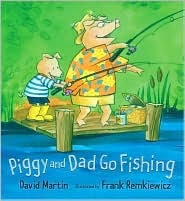
Very Busy Spider by Eric Carle
Read the book The Very Busy Spider by Eric Carle. Encourage adults and children to make the sounds of the animals.Early Literacy Aside--Example: Having your child hear and make the sounds of the animals in this story is one enjoyable way to help develop phonological awareness, to eventually be able to hear the smaller sounds in words. Submitted by Nancy Gattoni, Roanoke County (VA) Public Library
Pete's a Pizza by William Steig

Submitted by Linda White, Washington County (VA) Public Library
Old MacDonald Had a Farm Song
 Early Literacy Aside--Explain: Songs are a great way to incorporate the early literacy skill, phonological awareness. Hearing and learning animal sounds helps your children hear the smaller sounds in words and singing emphasizes different syllables. This helps your children later to sound out words.
Submitted by Wendy B. Rancier, Roanoke County (VA) Public Library
Early Literacy Aside--Explain: Songs are a great way to incorporate the early literacy skill, phonological awareness. Hearing and learning animal sounds helps your children hear the smaller sounds in words and singing emphasizes different syllables. This helps your children later to sound out words.
Submitted by Wendy B. Rancier, Roanoke County (VA) Public Library
Maybe a Bear Ate It by Robie Harris
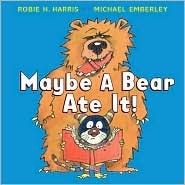
Submitted by Dawn Cheney, Glenvar Branch, Roanoke County (VA) Public Library
Old MacDonald Has a Farm Song
Early Literacy Aside--Explain: Researchers have found that one of the early literacy skills is phonological awareness. This is the ability to hear and play with the smaller sounds in words, like rhyming, playing with syllables or parts of words, and hearing beginning sounds of words. The beginning of this skills starts with children hearing and saying the sounds of animals.Sometime durng storytime sing "Old MacDonald" with the children, including several animals--cow, pig, sheep, chicken, duck, etc. Early Literacy Aside--Example: Making the sounds of animals contributes to phonological awareness and hearing sounds in words. Early Literacy Aside--Empower: Take advantage of opportunities to sing and say the sounds of animals with your children. It's fun and it also helps them hear the smaller sounds in words.
Submitted by Kimberly Burnette-Dean, Roanoke County (VA) Public Library
Blue Goose by Nancy Tafuri
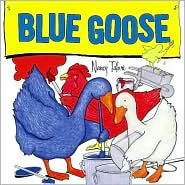
Jazzmatazz! by Stephanie Calmenson
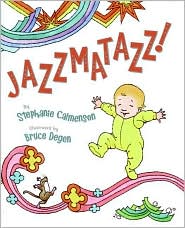
Help! A Story of Friendship by Holly Keller
 Early Literacy Aside--Explain: When you help your children pay attention to the print in books, you are helping to develop their print awareness, one of the early literacy skills that will later help them learn to read. I'll point out a couple of things in storytime today that will support this skill.
Read the story Help! A Story of Friendship by Holly Keller. [When you come to the page with the deep hole, you have to turn the book the long way.] Wow! This hole is so deep we have to turn the book around. Look the writing changed direction too!
Early Literacy Aside--Example: Children's attention often goes to the pictures. By pointing out the direction of print you help develop your children's print awareness.
Early Literacy Aside--Explain: When you help your children pay attention to the print in books, you are helping to develop their print awareness, one of the early literacy skills that will later help them learn to read. I'll point out a couple of things in storytime today that will support this skill.
Read the story Help! A Story of Friendship by Holly Keller. [When you come to the page with the deep hole, you have to turn the book the long way.] Wow! This hole is so deep we have to turn the book around. Look the writing changed direction too!
Early Literacy Aside--Example: Children's attention often goes to the pictures. By pointing out the direction of print you help develop your children's print awareness.
Thank You Bear by Greg Foley
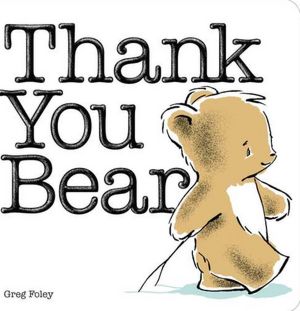
Talk about how what is special to one person might not be special to another. People see things and use things differently.Read the book Thank You Bear by Greg Foley. Activity: Pull out a cardboard box and have the children act out the story. You are the bear. There can be as many monkeys, owls, elephants, etc. as there are children who want to be that animal. Then talk together about the many things you can do with a box. Early LiteracyAside--Example: Acting out stories and having children say parts helps develop their narrative skills, the expressive part of language. Retelling stories is one way that children will later more easily understand what they read. If your child did not get a chance to talk about how they might use a box, listen to their ideas on the way home.
Early Literacy Aside--Empower: Here is a handout for making stick puppets. Using props or puppets is one fun way to encourage children to retell stories at home. It is activities like this that you do with your children that set them on a strong road to reading, in this case helping them understand what they read and how stories work! Puppets: Patterns for making stick puppets. The pattern for the mouse is here, but I use a mouse puppet. The pattern for a bear is also here, but I make myself the bear when I am retelling it with these stick puppets. Thank You Bear stick puppets
